This month’s PB author interview is with Florida snowbird Shutta Crum. I confess—I’m a fan of Shutta for three main reasons.
- She has the greatest name.
- She did a bang-up job in critique sessions for my own PB writing at two different SCBWI regional conferences.
- She’s amazingly generous to other writers—especially early-career ones.
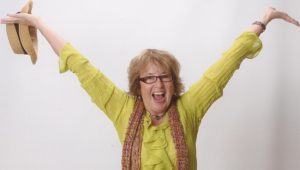 Back to the regularly-scheduled introductory bio! Born in Kentucky and raised in Michigan, Shutta is a children’s author and poet. But she’s also “a lecturer, a teacher, a storyteller, a mother, a grandmother, a retired librarian, an educator, as well as someone who is intoxicated by color and 3D doodling. (I make quilts, do mosaics, and glue together strange things I find when I’m not writing.)”
Back to the regularly-scheduled introductory bio! Born in Kentucky and raised in Michigan, Shutta is a children’s author and poet. But she’s also “a lecturer, a teacher, a storyteller, a mother, a grandmother, a retired librarian, an educator, as well as someone who is intoxicated by color and 3D doodling. (I make quilts, do mosaics, and glue together strange things I find when I’m not writing.)”
Shutta is the author of numerous books for children, ranging from those for the very young (Uh Oh! and Mine!) to the standard PB-age kid (Thunder-Boomer! and The Bravest of the Brave) to much older readers (the almost-middle-grade book Thomas and the Dragon Queen and the middle-grade novel Spitting Image). Plus she writes poetry for adults. And I can speak with authority on these last bio-worthy points—she’s a natural public speaker with a keen sense of humor and a storyteller’s soul.
Website: www.shutta.com
Blog: blog.shuttacrum.com
Facebook: www.facebook.com/ShuttaCrum
Twitter: twitter.com/Shutta
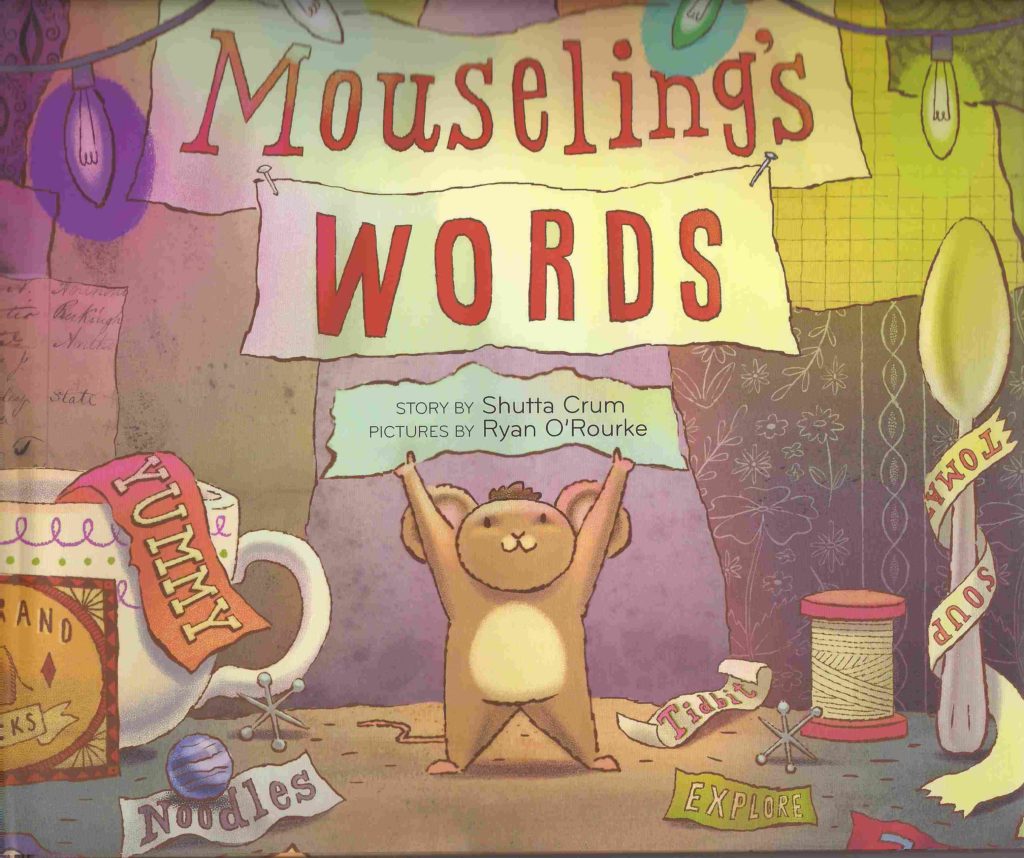 RVC: Sometimes an author’s point of view choice feels absolutely perfect for a book, as does 1st person for Mouseling’s Words. How do you know when you’ve got the right POV?
RVC: Sometimes an author’s point of view choice feels absolutely perfect for a book, as does 1st person for Mouseling’s Words. How do you know when you’ve got the right POV?
SC: This is a great question, and one that I’m currently struggling with in a novel I’m writing. (Still the first draft.) It’s a dual narrative with alternating points of view. But … I’ve struggled with should the POVs be same? And the tense? Should it be the same? Would it be too confusing to use 1st person in one and 3rd in another? (Which is where I currently am with this manuscript. And present tense in both.)
I think the answer comes down to how close I personally feel to the protagonist(s). If I feel I can truly inhabit the character(s)—in fact, that the character is actually some facet of me as in Mouseling’s Words, which I tell people is my “auto-mouse-ography”—then I’m more likely to use 1st person. If I feel like a storyteller standing outside of the action, then it feels like it should be 3rd person. But even using 3rd person, I really have to be “into” my character(s). So it seems to me that that kind of decision is about how comfortable/uncomfortable I am as the creator of a piece of writing.
Sometimes my critique groups or beta readers will disagree with the POV I’ve chosen. I do add their voices to my internal debate about it, but in the end it’s really about how I feel as I’m writing. After all, writing a book is a journey, and I have to enjoy that journey. Otherwise, what’s the point? In the end a book is a product that an author hopes will nourish its readers—but for the writer, it’s the journey that’s the nourishment.
RVC: Can you recommend some published PBs that really show how to make the most of 1st person? 3rd?
SC: Well, there’s a ton of great 3rd person picture books. In fact, a writer I know was told by her editor to change her 1st person POV picture book into the “usual” 3rd. Not sure I could have done that. But it’s always worth experimenting. I’m currently working on a 1st person POV picture book. It’s a bit long. So I’m going to try it in 3rd soon to see what effect that has and if it helps to shorten the storytelling. But in the meantime, let me shout out for a couple of my favorite 3rd person picture books—and then a longer list of 1st person, as I think that is a bit rare.
I’m overwhelmingly in true love with Real Cowboys by Kate Hoefler. She’s a poet, and the story is told in 3rd person plural prose poetry. The illustrations by Jonathan Bean are gorgeously lit and reflect the heat of the range and the swirling dark of a storm. I adore it. Can you tell? Just the cover makes me almost swoon—the light hitting right at the heart. Jonathan should have gotten a Caldecott for this.
As to other 3rd person POV books I love: Shrek! by William Steig (the non-movie version original), Tara Lazar’s 7 Ate 9, and the Caldecott Medalist by Peggy Rathmann, Officer Buckle and Gloria. Also, there’s the wonderful book by Linda Sue Park, The Firekeeper’s Son, illustrated by Julie Downing, and, of course, the classic Maurice Sendak book Where the Wild Things Are.
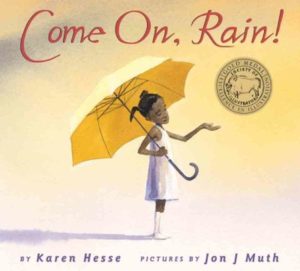 1st person POV in picture books is less common. Those I think are worthy mentor texts include the hilarious, well-plotted, and beautifully illustrated Saving Sweetness by Diane Stanley, illustrated by G. Brian Karas. As well, I adore Karen Beaumont’s I Ain’t Gonna Paint No More!, illustrated by David Catrow. Then there’s the incomparable Owl Moon by Jane Yolen, a Caldecott medalist illustrated by John Schoenherr. Also, I have to shout out about the lovely, lively Come on, Rain! by Karen Hesse and illustrated by Jon J. Muth. Finally, I want to recommend a book by an author who is a master of repetition without creating boredom, Bill Grossman. Check out My Little Sister Ate One Hare.
1st person POV in picture books is less common. Those I think are worthy mentor texts include the hilarious, well-plotted, and beautifully illustrated Saving Sweetness by Diane Stanley, illustrated by G. Brian Karas. As well, I adore Karen Beaumont’s I Ain’t Gonna Paint No More!, illustrated by David Catrow. Then there’s the incomparable Owl Moon by Jane Yolen, a Caldecott medalist illustrated by John Schoenherr. Also, I have to shout out about the lovely, lively Come on, Rain! by Karen Hesse and illustrated by Jon J. Muth. Finally, I want to recommend a book by an author who is a master of repetition without creating boredom, Bill Grossman. Check out My Little Sister Ate One Hare.
I could go on and on. However, there’s a good list of these 1st person POV picture books at: https://annaforrester.wordpress.com/tag/first-person-narration-in-picture-books/
RVC: It’s clear that you’re a big fan of mentor texts. Does a mentor text lead to a story, or is it the other way around? How do you read a mentor text differently than other books? What do you do if you can’t find an appropriate mentor text for a project?
SC: Of course, some books engender ideas which come into being as other books. I found this particularly helpful while I was a librarian and being around so many wonderful books. And I have another writer friend who, when she needs a fresh idea, spreads out a bunch of recently-published picture books and lets her mind wander among them for a way to put together something new.
Generally, I don’t use mentor texts to lead to a story. The ideas just seem to come. Sometimes, they’ll percolate for years before finally rising to the surface with a bunch of disparate yet connected strands pulled from living an observant life. I’ve never then said, “OK, now I need a mentor text to guide me through the project.” I don’t use mentor texts that way.
However, I love learning from the writing of others, and I tend to use mentor texts mostly as a way to hone my craft—not for particular projects. That is, I read broadly and take note of the books I love and the techniques used. My reading is partly to facilitate my teaching, but also to allow me to go, “Ah-ha! Look at this cool thing that so-and-so has done.” I’m sure that although I don’t use mentor texts to work through specific manuscripts, the things I’ve noted are there in the little gray cells and they get used as I write.
One thing I did when I first began my journey as a writer was to type out the text of picture books I loved so I could see how they were laid out on the page without illustrations. This was particularly instructive about how the artwork melds with the text. Of course, by the time a book is published, it’s been edited and the text may not look like the original submission. But that’s okay. It still gave me an idea of the ideal I was striving for.
RVC: There’s always a story behind someone’s first published story. What’s yours? What was the process of getting that first PB published?
SC: Actually, the best story is about the first picture book I wrote—but it was the fifth one published. I had just finished reading Cynthia Rylant’s When We Were Young in the Mountains and I thought “Dang! She just wrote my story.” At that time, I’d also come across a poem about a young girl in the mountains, so I decided to try my hand at writing a poem about what it was like to spend summers with my relatives in the mountains of southeastern Kentucky where I was born. So I wrote a poem. Folks who heard it said it sounded like a story, you should tell it. So
I then wrote My Mountain Song. I submitted it and it got one rejection—though it was a very nice hand-written one from Paula Morrow. I put the manuscript away for about 18 years! I figured with one rejection maybe I just wasn’t meant to write for kids. Geesh!
Eighteen years later, when I realized that all writers get rejected I pulled it out and started submitting it. Over the course of its pre-pubbed life it garnered thirty-five rejections! However, with each one I’d get asked to submit something else because my writing was liked. And on the strength of that story, I sold 6 other books!
I was also hearing that the reason it was getting rejected was that the editors felt there was more to the story, it should be a novel. So I started writing a novel based on the characters from my poem and my picture book. When I finally got an offer on My Mountain Song, the editor, Dinah Stevenson of Clarion, said to send the novel, too, when it was finished!
As it turns out, the novel was published before the picture book. It took 4 years for my picture book to work its way through the long list of books the inimitable Ted Rand was illustrating. My book was one of his last. After the book came out he sent me an original painting from it. Such a lovely gesture, and a kind man. Anyway, the upshot of this story is that an idea became a poem, then a picture book, and finally a novel. One never knows the circuitous route a bit of storytelling can take. And, of course, never give up—pull those manuscripts out of the drawers they’ve been languishing in and go for it!
RVC: What does your writing area look like?
SC: A mess! (See the photo.)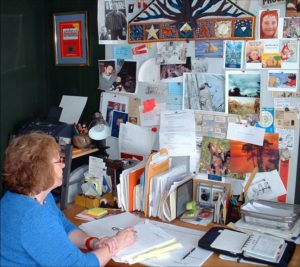
RVC: Speed round! What are the four Hs of picture book writing?
SC: Heart. Hurt. Hope. Humor.
RVC: Which H is the hardest for newer picture book writers to master?
SC: Strangely enough, I think it’s heart. Beginning writers get so caught up in a joke, or a cool plot twist that they forget the most important element of the 4‑Hs.
RVC: Share your reaction to being invited to the White House Easter Egg Roll in 2015.
SC: Incredulity. When the phone call came from my publicist at Knopf, I put my husband on the line thinking it was a prank call.
RVC: When it got cancelled after you got there due to inclement weather, you …
SC: … felt saddened for the families that had camped out in stormy weather all night on the sidewalks around the White House. We’d already had breakfast and I’d sat nervously on the incredible antique furniture in the W.H. worrying that I’d spill my coffee by the time they officially called it off due to lightning. So after a few announcements by the Secretary of Education, photos, and applauding by all we did a small tour and went home. Sigh … At any rate, the ride in the limos, the gift basket, and eating in the White House was fun. Funny thing though, they confiscated my picture books and I was told that they would be given back to me just prior to my reading—as though I’d try to hide some sort of weapon within a skinny PB!
RVC: Three words that you hope come to mind when people read your PBs.
SC: Heart. Hope. Humor. (I don’t necessarily want them to remember the hurt except as it is connected to the revealing of heart.)
RVC: One picture book you would have LOVED to have written.
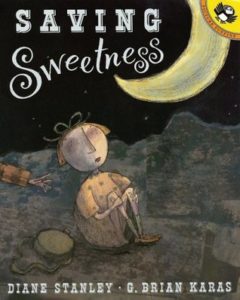 SC: Real Cowboys by Kate Hoefler. What more can I say than I’ve said above? I adore it. I could reread it a million times. A close second would be Saving Sweetness by Diane Stanley—it has the 4 Hs in abundance. Strange that I wouldn’t have picked an international bestseller .… Perhaps because I’m not into this just for the income—such as it is.
SC: Real Cowboys by Kate Hoefler. What more can I say than I’ve said above? I adore it. I could reread it a million times. A close second would be Saving Sweetness by Diane Stanley—it has the 4 Hs in abundance. Strange that I wouldn’t have picked an international bestseller .… Perhaps because I’m not into this just for the income—such as it is.
RVC: Thanks so much, Shutta!
****Bonus Opportunity for Writers!!****
Thanks to Shutta’s generosity, she’s offering a FREE critique of a picture book manuscript—or the first 10 pages of a middle grade manuscript—to a randomly-picked person who comments on Shutta’s Facebook page about this interview in July 2018. Here’s a link to where you should post those comments. Good luck!


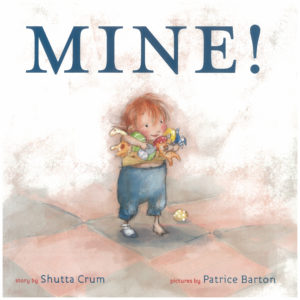
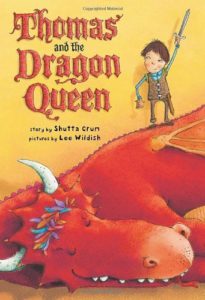
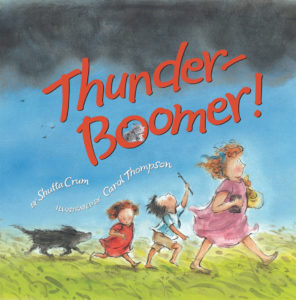
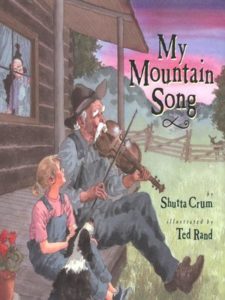
Thanks so much for being you, and being an author in support of the 4 hs.
I am in awe of what you do for little ones.
‑Lori
Just make sure that you post a comment about the interview on Shutta’s FB, too. That’s where she’ll pull a name from for the giveaway. The link is at the bottom of the interview above. Thanks!
Great interview with a great author. Thanks Ryan!
Just make sure that you post a comment about the interview on Shutta’s FB, too. That’s where she’ll pull a name from for the giveaway. The link is at the bottom of the interview above. Thanks!
More words of wisdom from Shutta. Thanks for the great interview.
Just make sure that you post a comment about the interview on Shutta’s FB, too. That’s where she’ll pull a name from for the giveaway. The link is at the bottom of the interview above. Thanks!
Wonderful interview–I always learn something when I read anything that Shutta’s written. And am copying the PB suggestions!
Just make sure that you post a comment about the interview on Shutta’s FB, too. That’s where she’ll pull a name from for the giveaway. The link is at the bottom of the interview above. Thanks!